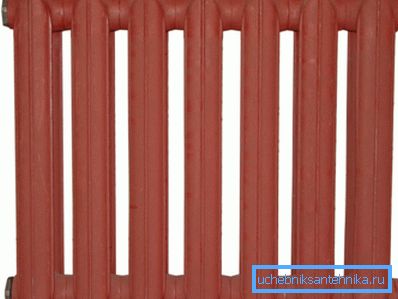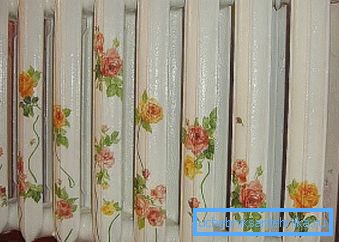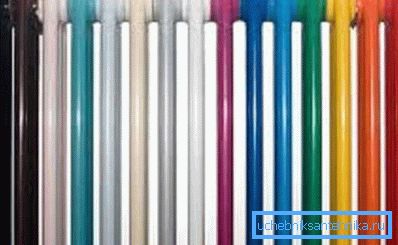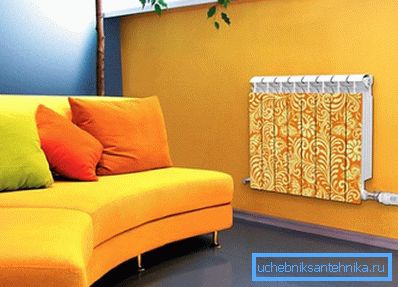Heating radiator decor: decoupage, decorative screen,
The radiator does not always occupy a worthy place in the interior - it is often perceived as a permanent attribute of a house or apartment that cannot be abandoned, you have to put up with it and do not pay attention to the fact that this item does not fit into the environment.
Yes, it is a habit, but you should get rid of it, because in addition to heating, the heating devices in the room can become part of the overall design of the room and then you won’t even think that it would not hurt to replace them with a floor heating system. There are several ways to decorate batteries, and we want to tell you about them, and we also want to show a video in this article that answers the topic.

Radiators, as part of a beautiful interior
What they are like
Note. All radiators of water heating can be classified according to three criteria: according to the type of fixation, according to the type of configuration, and according to the metal they are made of, which also has a significant place in the design.

- According to the type of installation, heating devices can be either mounted, that is, mounted on the wall with the help of brackets in the form of hooks, or floor, where brackets are used as legs;
- By configuration, they are divided into column (sectional), tubular and panel. Although, in essence, they are all tubular, nevertheless, this category includes devices with open tubes that do not disassemble into sections. So, the tubular device itself can become a design element, since it is not necessary to paint radiators of this type - they are often made of stainless steel, which is beautiful in itself. There remains a sectional and panel view, although, if manufacturers care about the design of their products, they can be used without any changes in modern interiors, for example, in high-tech design;
- And finally, metal - it can be steel, aluminum, bimetal and cast iron (the price is very different), but if the first three can be used without resorting to decoration in order to blend in beautifully with the interior, then for cast iron this is perhaps a necessity.
Decoupage
Note. Decoupage is the technique of decorating objects by applying or sticking a pattern on it and covering this image with paintwork materials.

At the moment, the technique of decorating surfaces with the help of decoupage is extremely fashionable and this also applies to heating devices - the instructions for their installation and operation do not in any way prevent the application of a small layer on the surface of the heater.
Moreover, the stores offer a wide range of materials that allow not only to create a pattern or image, but also to use the aging technique, to apply three-dimensional drawing and ornament. Of course, our own cast-iron batteries, which we used to hide behind curtains and curtains, are in the greatest need of this, reducing their heat transfer.
Decorative screen

Decorative screens themselves are not a new idea, and have long been used in the design, so decorating heating radiators in this way also takes place, and quite a lot, if not the main thing in the design of heating devices.
To create a screen, as a rule, three types of materials are used - metal, plastic and wood, but in any case it should be made in the form of a grid, in any case, there should be enough holes, the area of which will allow warm air to pass freely. In addition, such a device allows you to use the picture, for example, as shown in the top photo.

But for lovers of DIY-interior there is an excellent opportunity to dream up, that is, to make the screen yourself, and for this you can use not only traditional metal, wood and plastic, but also woven materials, for example, as in the top photo.
But in this case, you should be prudent - the fabric is also a certain obstacle for convection, so if you decide to sew a nice original case, then take care that there are holes in it. For such a screen is not desirable to use synthetics - the best natural fabrics.
Painting and printing

The problems of decoration of heating devices can be solved with the help of paints that are used for metals, and here they do not even need heat-resistant coatings, since it is unlikely that the surface of your battery can heat up more than 80? C.
Of course, cast-iron batteries generally need to be painted in any case, even if you do not need to decorate the room, but if, for example, they are made in different colors, as shown above, then the interior of the room will immediately acquire vitality and attractiveness. Only now the color will need to be selected according to the painting of the walls or the tone of the wallpaper, as well as taking into account the design of the furniture.

A very convenient type of design, it is a seal on radiators, and this is best obtained on steel (panel) and bimetallic (sectional) models. Such a miracle is made on wide-format printers that have the possibility of a high head lift, at least 100 mm. But the device, of course, for this you need to remove from your seat.
Conclusion
Even a primer for heating radiators, that is, any primer used for metal surfaces, for example, glyptal (GF), can become a decoration tool. If you cover it with a cast iron battery in accordance with the tone of the wall, the heater will not cut the eye and fit into the interior of the room.